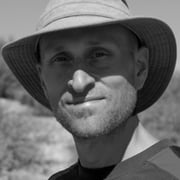In some places, the weather is small talk; a topic to politely fill the time or chat with a stranger. Elsewhere the weather is a force that stops you in your tracks and reshapes the pattern of your day. For Serge J-F. Levy, the weather in his adopted hometown Tucson, Arizona, spun him into making a 180-degree turn. “I first came to Arizona at the end of July, 12 years ago, and there were these torrential downpours. I was driving across a bridge and there were people lined up gawking down into the wash,” he recounts. “At the time, I was very judgmental, thinking: ‘oh come on, what’s going on?’ And of course, now, I am the one gawking at these phenomenal openings of the sky.”

The monsoons that storm across the Southwest are dramatic. They cause dry river beds to flood, soil to be enriched, and people to pause in wonder or hurry for shelter. The drama of the monsoons paints a broader portrait of the desert—one in which cycles of wet and dry, life and death are vividly on display.
In Where the Edges Vanish, Levy has taken the desert landscape as his collaborator, venturing into the brush to look closer, discovering a land of boundless parameters, equal parts beautiful and bleak, brimming with enthralling details. At times lush, at times desiccated, the desert is a raw reflection of life. Levy strives for the images to be true to the landscape—difficult, uncomfortable, yet seductive. The images take in the smallest details of pattern and the grand scale of these arid spaces. Natural lines arc and sprawl, leading from one image to the next. Photographs are paired together, slightly off kilter or shifted to stretch out a tree’s bend or mimic a ridgeline.

Levy arrived in Tucson from New York having cut his teeth as a street and documentary photographer. He moved to Arizona to further his studies and make landscape photographs, studying under the likes of Frank Gohlke of the New Topographics movement. Yet Levy’s first forays into this new artistic territory were difficult, a cerebral impulse to plan and direct overtaking him. Equipped with his knowledge of the history and background of landscape photography, he allowed the intuitive experience of street photography to guide him into a new approach to making images.
“I realized that the photographs where I had an idea of what a landscape photograph was supposed to be were failing but when I was spontaneous and walking without an agenda that was it. That was a revelation, to do this in a responsive, spontaneous way.”

In returning to his photographic roots—shaped by the flow of exploring the unpredictable hustle and bustle of the streets—Levy found a way to connect more meaningfully to nature. A full emotional and physical immersion has become his working method. Going out into the desert, hiking and sleeping under the stars, challenging himself, as he says, “physically, emotionally, and creatively.” For Levy, this exercise brings up a vital question: What does it mean to live life not in the pursuit of happiness but in the pursuit of living life? “There’s a full range of feelings and emotions there,” he says.

In Levy’s images, one finds this mix. Cacti in vivid bloom give way to tangles of dead, interlocked branches. One moves through these landscapes, animated by the cycles of life and death, alongside the photographer. A hand caught in the thorns of an acacia bush is accompanied by the delicate shadows of branches on a sun-soaked rock. Taking a step back, one finds desert vistas of red rocks and animal skeletons whilst the rough facades of rocks break into squares of gray.

Levy’s attention to detail reveals a landscape in motion. Shadows creep up the bottom of an image, the darkest swath of ombré across a hillside. In some images, the shadows take forms as if characters found amid the dried-out landscape. The clarity of some photographs feels almost surreal as if we are looking at a history museum diorama and not at a natural view. This shock of crispness speaks more to our own biases, to the references we hold, and to our unsteady, blinkered connection to the natural world.

The concept of the wilderness as a place of refuge is limiting for Levy—it misses the full scope of what these spaces are. “I don’t have a problem with people using the wilderness as a refuge,” he muses. “The full experience is for me to live the broadest truth, which is often laden with really painful experiences and reflections on loss and regret. It is a place of dynamic range. I’m not getting away from where I am, I’m getting deeper into something.”
In one particularly striking image, a saguaro cactus stands nearly dead center. Two arms of the cactus reach out to each other, one upwards, one down. They are so close to forming a perfect loop yet not quite there. Perhaps on a return they might have fully found each other, but for now they hang ever so close, growing slowly, on desert time.

For Levy, the photographs are a testament to his experience of the desert, almost a secondary act to the physical movement of exploration. As the title of his series indicates, once out in the desert, the edges vanish. The landscape takes over. “It’s about learning to accept that this is what’s there. Learning to love the desert has been learning to have a relationship with the desert,” he elaborates. “There is a whole other wealth of experience to have beyond the visual—it’s tactile, it’s emotional, it’s a consuming experience.”
If you look closely enough and let yourself be pulled in, you’ll feel the burn of the heat on your neck, smell the earthy scent of creosote, and if you pause, you might just hear a soft rustle in the brush that tells you that the desert is alive.
















